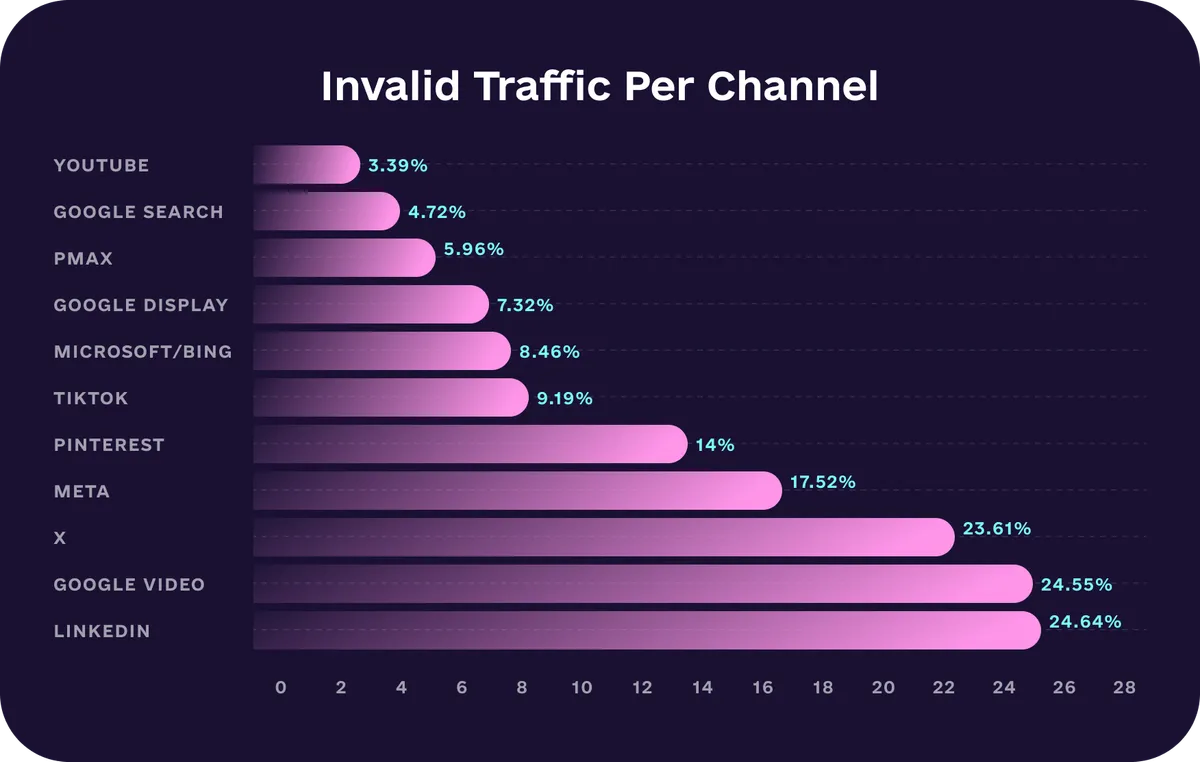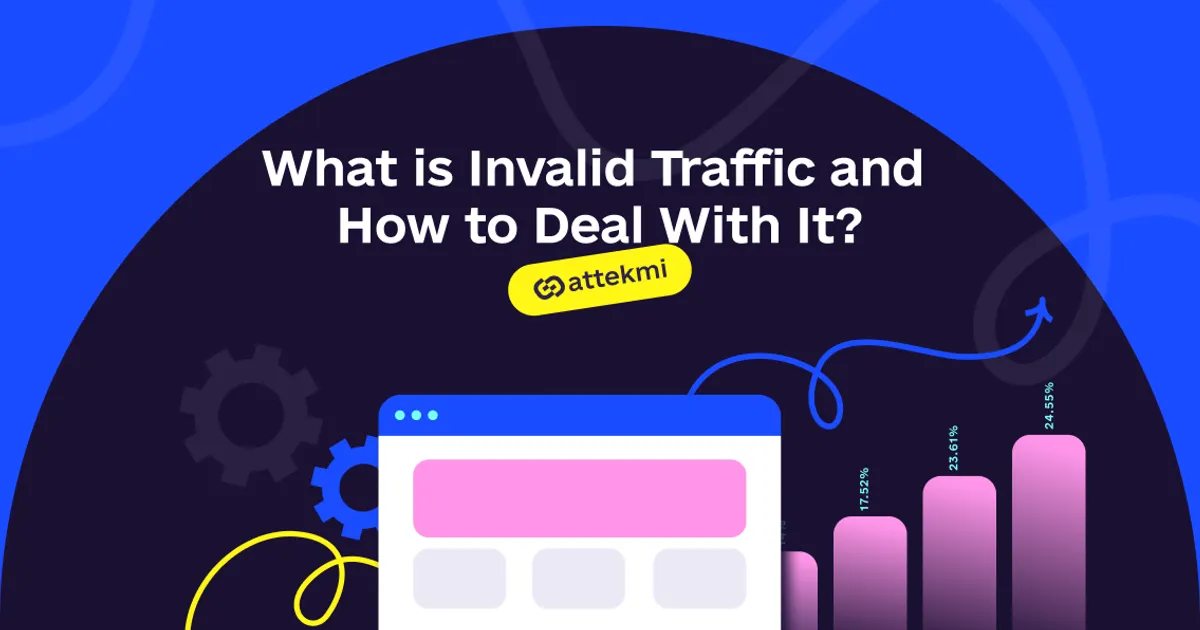Invalid traffic can be intentional and unintentional, but it may still affect both publishers and advertisers. However, what is invalid traffic? Why does it occur? Our guide is here to answer these and other questions.
What is invalid traffic (IVT)?
Basically, invalid traffic is all about impressions and clicks that artificially inflate the advertiser’s expenses. These can be generated by users with no interest in the content and web traffic bot.
In any case, invalid clicks (or impressions) bring no value to marketers, while publishers with the wrong ad placement strategy also face certain challenges. For instance, a user may click an intrusive ad unintentionally while trying to close it. Such an action does not increase the advertiser’s conversion rate, and the user experience is affected as well.
What are the different types of invalid traffic?
In short, invalid traffic comes in two forms: general and sophisticated. Let’s take a closer look at them.
General invalid traffic (GIVT)
General invalid traffic (or GIVT) does not imply malicious activities — instead, it refers to internal traffic and accidental clicks. This invalid traffic type is rather easy to discover:
Known data centers: impressions come not from real users but from data centers.
Unknown browsers: these can be non-browser user-agent headers and other forms of unknown browsers. However, such programs or devices cannot be identified as standard web browsers, so the traffic coming from them is invalid.
Bots and spiders (or other crawlers): traffic is generated by automated programs, not humans.
Activity-based filtration: impressions are identified by analyzing user activity patterns suggesting non-human interaction.
Pre-fetch or browser pre-rendered traffic: impressions are generated before the actual content is loaded on the screen.
Sophisticated invalid traffic (SIVT)
As for sophisticated invalid traffic (or SIVT, if short), it is mostly about fraudulent traffic and inaccurate data.
In terms of detection, it is harder to discover than the general IVT invalid traffic type. Here are several types and reasons for such traffic:
Automated browsing: this is the browsing activity from software or devices that are not controlled by humans (for instance, these can be bots).
Incentivized activity: this is the invalid activity generated by humans who are incentivized to do so. For instance, they may click an ad to get a reward.
Manipulated activity: these can be forced clicks or fake conversions. In any case, that is the activity that seems to be valid traffic.
Falsified measurement events: these are fake or invalid clicks, impressions, and conversions.
Advanced bots or crawlers: such bots or crawlers are simply too sophisticated to get detected as invalid traffic.
Hijacked ad elements: ads hijacked by malicious actors and serving invalid traffic.
Invalid proxy traffic: traffic originating from invalid proxy servers.
Adware and malware: software generating invalid traffic.
Cookie manipulation: using cookies to manipulate user data or generate invalid traffic.
GIVT vs SIVT: comparative table
For an advertiser (or publisher), any type of invalid traffic is a challenge. However, to clarify the difference between general and sophisticated invalid traffic, let’s compare them.

Major reasons of unintentional invalid traffic
Every invalid click matters, but many of them come unintentionally. You are already familiar with the most common types of invalid traffic, but let’s take a closer look at the major reasons why it is happening.
Purchased traffic
For publishers, purchased traffic can be effective in the short term, but in general, it is still a dead end. Instead, publishers should prioritize human traffic over special software and farms generating clicks. This can be done by improving user experience, delivering great content, and optimizing the website for search engines.
Getting hacked
Certain bots, like SEO crawlers, can be helpful, but others may cause a lot of harm. One of the best things website owners can do is change the default login URL. After this, bots trying to attack the CMS get redirected to a 404 page instead.
Redirected or expired domains
Buying an expired domain can bring numerous benefits to a publisher. For instance, it may still have good authority and some fine backlinks. However, purchasing an expired domain also implies not knowing where the traffic comes from. To solve this problem, publishers must check the server log files. Besides, if there is Google Analytics available for redirecting URLs, it is crucial to look at what redirects are being hit and where that traffic comes from.
How can invalid traffic affect your business?
In short, invalid traffic is not something good, whether it’s intentional or not. However, let’s review the potential consequences in detail.
Affected ad spend
Every invalid click contributes to the wasted budget, which is a problem for any advertiser. Obviously, a single fraudulent (or unintentional) click will not make a big difference to the performance of the campaign, but when there are a lot of them, the advertising budget is simply wasted. In 2024, the ad spend wasted on invalid traffic reached 33%:

Therefore, it is crucial for marketers to track and filter out invalid traffic, while owners of ad exchanges should integrate scanners to detect such issues and ensure a safe ecosystem for their partners.
Issues with the data
In the world of digital marketing, data is everything for both advertisers and publishers. Analyzing it enables making data-driven and, as a result, effective decisions. However, if the data gets affected by invalid traffic, it becomes less useful. For advertisers, it is crucial to keep the data as accurate and clean as possible.
Wrong resource investment
A lot of invalid clicks may make advertisers invest more resources into the wrong channels that do not deliver the desired results. Moreover, that is not only about the wasted budget but also effort and time. Detecting and blocking invalid traffic is among the most important tasks for any marketer to prevent this issue from happening.
Inaccurate audience profiles
Additionally, invalid clicks can “pollute” the advertisers’ customer profiles. As a result, marketers may target users who are not really interested in their offer, which means wasted budget, time, and effort. Precise analytics and cleaning up the data are ways to create accurate and real profiles that will help increase the conversion rate.
Problems with the leads
Invalid users bring no value, but they can still request demos, download reports or other documents, and fill out forms. As a result, marketers may spend time trying to convert these “leads” into clients, which, obviously, brings no results.
Finding out which leads are invalid is crucial for advertisers in order to manage the sales resources properly. Otherwise, they may spend time on irrelevant activities.
How to find and eliminate invalid traffic (IVT) on your website?
Tracking and preventing invalid traffic is an important task for all parties involved in digital advertising. For instance, owners of ad exchange platforms can integrate demand and traffic scanners to minimize the probability of fraudulent clicks and malicious creatives. However, publishers are still the main people in charge of invalid clicks, so here are several suggestions for them on how to overcome this issue.
First, it is essential to apply the bot filtering setting in Google Analytics. Additionally, publishers should have their traffic validated by a third party and strictly follow the guidelines for ad serving. One more recommendation, even though it is extremely obvious, is to never click on your own ads. That is not intentional invalid traffic, but such clicks can still affect advertisers’ data and decisions.
Other recommendations that should be kept in mind are as follows:
Learn everything about your traffic: for instance, when the peak hours are, how much time people spend on your website, and so on. The more you know, the easier it is for you to optimize your strategy.
Build connections with reputable partners: ad networks, marketers, etc. Actually, this recommendation is relevant to anyone involved in programmatic advertising. Besides, both advertisers and publishers may apply black and whitelists to ensure proper traffic. Going for direct or preferred deals can also be a great help.
Do not pay for website traffic: paid traffic is almost always delivered by bots. Even if these bots do not affect advertising campaigns, they still mean unreliable data. Therefore, publishers should avoid them and focus on improving their websites instead. In the modern competitive world, creating engaging content and delivering value to users is much more effective.
It is also essential to remember that dealing with invalid clicks is not a single task to complete. Such issues should be monitored and prevented continuously across all the channels.
To identify invalid traffic, publishers should also pay attention to the bounce rate. Bots do not tend to spend a lot of time on a website, so a high bounce rate can indicate a problem with fake clicks. Low session duration, traffic peaks with low conversion rates, and repeated traffic patterns can also be signs of traffic problems. For instance, if the bounce rate is higher than 70%, there may be a problem with bots, which should be avoided at all costs.
Consider Attekmi your trusted partner
At Attekmi, we aim to deliver an impeccable experience to our partners. Therefore, our solutions (including AdEx Basic) are equipped with scanners like Pixalate, Forensiq, and Fraudlogix to keep your platform safe. And that is not the only benefit of our products.
Additionally, we offer cross-bidding integrations (like VAST to RTB), cover all the essential digital environments (desktop, in-app, mobile web, and CTV), and help our partners earn on various types of ads (banner, native, video, etc.). One more thing to keep in mind is that our solutions have advanced targeting and filtering capabilities so that you can match demand and supply efficiently.
You can also opt for our White Label Ad Exchange — this implies total customization and developing all the features that you request. Everything is just up to you.
For instance, Roqoon Media managed to achieve 262% revenue growth in three months, and you can reach the same heights. Feel free to explore other case studies here.
Does Attekmi sound like the right choice? Then let’s talk!
FAQ
Invalid clicks do not benefit advertisers or publishers. While for marketers, the main problem is wasted advertising budget (and effort), publishers may suffer from poor user experience.
For publishers, it is crucial to know everything about their traffic — this can be done by using special tools. Additionally, it is essential to pay attention to the bounce rate — if it is high, this may indicate a problem.
Publishers need to keep an eye on their websites (or apps) and deliver the right content. In turn, marketers must track the performance of their campaigns in order to detect potential issues. Remember, invalid traffic can be both intentional and unintentional. However, the reason for this does not simplify the situation.
 By Iryna Kozirevych
By Iryna Kozirevych